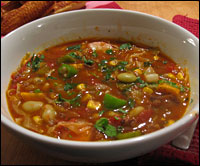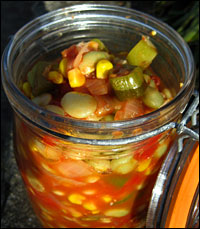
Photo: Library of Congress
In our food system, the part of the animal that delivers the most flavor — the bones — often gets thrown away. Purveyors then sell the boneless meat at a higher price. During hard times, such wasteful practices come into relief. We explore humbler, bone-in cuts of meat and underappreciated vegetables. And we begin to take leftovers seriously, putting them to use in other dishes. Amazingly, our cuisine actually benefits from this frugality.
Winter is the ideal time for trying your hand at such rustic, country-style dishes. Tough cuts of meat simmered slowly for hours transform into something so succulent you can literally eat it with a spoon. Long hours of hands-off cooking warm the house and fill it with irresistible, mouth-watering aromas.
I started exploring the more rugged cuts of meat a few years ago. At the farmers market where I shop for meat from pastured animals, the tough cuts tended to be the ones I could afford. Farmers seemed to have a hard time getting rid them, so I took on a challenge to find deals that benefited us both. I have adapted many of my favorite dishes to these economical cuts. Chicken and dumplings made with chicken backs, Gumbo Z’herbes made with pork neck bones, and oxtail country vegetable soup.
I have wanted to share the country vegetable soup of my childhood with you for a while. It is a meal that highlights the wisdom of my grandmother, who grew up during the Great Depression and was no stranger to hard times. She and many other women like her transformed underappreciated foods into delicious and nourishing meals day after day without ever consulting a recipe. It is the first dish that I long for when the weather turns bitterly cold. The only problem is that my grandmother’s vegetable soup requires thinking ahead. It is so well-loved that I make plans for it in July and August.
Summer in a Pot
In the summertime, I simmer fresh tomatoes with sweet corn, butterbeans, and okra, then put them by in the freezer as a winter “vegetable soup helper.” It’s actually a dish known as succotash, which in its purest state is a simple dish of lima beans and corn. The okra in my family’s recipe is evidence of the strong African culinary influence felt all across the Deep South.
It simply will not do to make this dish out-of-season, so don’t bother at this time. Just commit now to putting up a batch this summer to make a traditional country vegetable soup next winter. Since country vegetable soup is the ultimate improvisational meal, coming up with an alternative recipe to share was easy. Inspiration for this soup traditionally comes from surveying the contents of the refrigerator and the freezer, so that’s where I headed.
When I found leftover roasted root vegetables from dinner earlier in the week, I knew that would make a perfect, hearty winter vegetable soup. A leftover ham bone or chicken carcass, or even rich dried beans in their cooking liquid and the rind from a chunk of Parmigiano-Reggiano can replace the oxtails. Just let your leftovers guide you, but be sure that they are still of very high quality. If you wish to make your soup completely from scratch, you can do that, too. You will find that many underutilized but wonderful produce grows on throughout the winter. A wide array of root vegetables and greens make for a perfect for a winter vegetable soup. Whatever you do, serve your soup with some hot, crispy cornbread just like my grandmother would do. It just wouldn’t be the same without it.

Soup is good food.
Oxtail Vegetable Soup
Makes about 2 1/2 quarts or 8 servings.
1 1/2 pounds oxtails (about three 3-inch segments), patted dry
Salt and pepper
10 cups water (or beef or chicken stock)
One 28-ounce can of chopped tomatoes
2 sprigs of fresh thyme, or 1/2 teaspoon dried thyme
1 sprig fresh rosemary
1 small bay leaf
Pinch of allspice
3/4 cup chopped celery
3/4 cup chopped carrots
1-2 cloves garlic, chopped
2 sprigs thyme, or 1/2 teaspoon dried thyme
1 bay leaf
1 1/2 cups diced potato, cut into 1-inch cubes
3 cups chopped green cabbage
4 cups assorted vegetables (such as leftover roasted root vegetables or succotash — recipe below — or any raw vegetables)
1/2 cup chopped parsley, to serve
1 lemon cut into 12 small wedges or hot sauce, to serve
Heat 2 tablespoons oil in heavy large pot over medium-high heat. Sprinkle oxtails with salt and pepper. Add oxtails to pot and brown on all sides, about 20 minutes. Add water, tomatoes, and herbs and spices. Bring to simmer. Reduce heat to medium-low and skim well. Cover and simmer gently until meat is tender, stirring occasionally, about 3 hours.
Using tongs, transfer oxtails to a plate. Carefully pour cooking liquid into 8-cup glass measuring cup or large bowl. Refrigerate or freeze cooking liquid until fat separates from liquid (about 45 minutes in the freezer). Spoon fat from top of cooking liquid. Remove meat from oxtails; discard bones. Add meat to cooking liquid. This can be made ahead, covered, and refrigerated for several days.
Heat 2 more tablespoons oil in same pot over medium-high heat. Add onions, celery, carrots, garlic, potatoes, thyme, and bay leaf. Sauté until vegetables are golden, about 10-12 minutes. Add cooking liquid with meat. Add the chopped cabbage and any other raw vegetables. Bring to boil. Cover and simmer until potatoes are almost tender, stirring occasionally, about 15 minutes. Add the pre-cooked or leftover vegetables and heat thoroughly, another 8 to 10 minutes.
Season to taste with salt and pepper. Ladle into bowls. Top with parsley. Pass a bowl of lemon wedges or hot sauce at the table. Serve with plenty of hot, crispy cornbread.

Succotash.
Deep South Succotash, or Vegetable Soup Starter
File this recipe away for next summer. My grandmother always froze this recipe in quart freezer bags to avoid fooling with a pressure canner, and I now do the same. The nutrients are better preserved this way as an added benefit. If you don’t want to use plastic bags, you can freeze it in glass jars. Just be sure to leave plenty of space for the mixture to expand as it freezes. A surefire way to do this is just to allow it to freeze solid before placing the lid on the jar.
1 medium onion, chopped (about 1 1/2 cups)
1/2 teaspoon kosher salt
1 clove garlic, chopped
2 cups fresh corn kernels, preferably white, cut from the cob
4 medium ripe red tomatoes, peeled and coarsely chopped (about 3 cups)
2 cups fresh baby lima beans or butterbeans
1/2 pound fresh okra pods, topped, tailed, and cut into 1/2-inch rounds (about 2 cups)
1 cup water
Salt and ground black pepper
Heat the fat in a heavy saucepan over medium-high heat. Add the onions with the salt and cook, stirring often, until they soften, about 5 minutes. Add the chopped garlic and cook for 1 minute more. Stir in the corn, tomatoes, beans, and okra. Add 1 cup water. Bring to a boil over high heat, then reduce the heat to low and simmer until the vegetables are just tender, about 20 minutes, stirring from time to time. Season generously with salt and fresh ground black pepper. Serve i
mmediately or let cool to room temperature and put up in quart freezer bags for a delicious vegetable soup helper.


